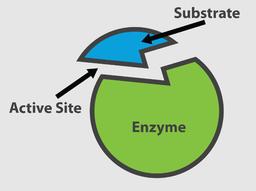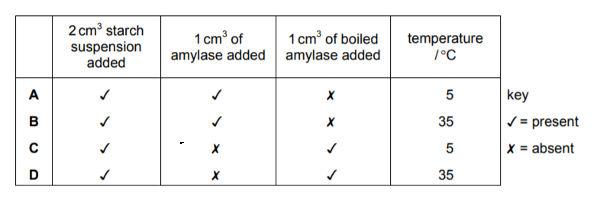
Enzymes . Revision
Quiz by Narimon Aliqulov
Feel free to use or edit a copy
includes Teacher and Student dashboards
Measure skillsfrom any curriculum
Tag the questions with any skills you have. Your dashboard will track each student's mastery of each skill.
- edit the questions
- save a copy for later
- start a class game
- automatically assign follow-up activities based on students’ scores
- assign as homework
- share a link with colleagues
- print as a bubble sheet
- Q1
Four test-tubes were set up as shown in the table.In which test-tube would starch be broken down the fastest?
B
C
D
A
60s - Q2
An experiment was carried out to investigate the effect of pH on enzyme action. The graph showsthe results. What are the labels for the x-axis and the y-axis?
D
B
A
C
60s - Q3
The graph shows the activity of three digestive enzymes at differing pH levels.Which statement is correct?
Enzymes X and Z are both active at pH4.
Enzymes X and Y are both active at pH7.
Enzymes Y and Z are both active at pH8.
Enzymes Y and Z are both active at pH4.
60s - Q4
The apparatus shown is used for an experiment on starch digestion.Which test-tube contains the most sugar after 20 minutes?
C
D
A
B
60s - Q5
A student wrote some notes about enzymes.She wrote:‘The ......1...... of the enzyme is ......2...... to an area on the substrate.This area on the substrate can fit into it to form an ......3...... complex’. Which words correctly complete gaps 1, 2 and 3?
D
A
C
B
60s - Q6
The graph shows the effect of temperature on the action of an enzyme. Why does the rate of reaction change when the temperature is increased from 20 °C to 30 °C?
B
D
C
A
60s - Q7
The graph shows how an enzyme-controlled reaction is affected by temperature.Which statement explains the change in activity between X and Y?
There are more effective collisions.
There is more substrate present
The kinetic energy of the molecules has increased.
There is a change in the enzyme shape.
60s - Q8
What is the correct definition of the term enzyme?
carbohydrates that act as substrates
proteins that act as substrates
carbohydrates that act as biological catalysts
proteins that act as biological catalysts
60s - Q9
The diagram shows the effect of an enzyme working in the human digestive system.What would reduce the rate of production of amino acids?
raising the pH to 7.5
raising the temperature to 37.1 °C
removing the amino acids as they are formed
increasing the amount of protein
60s - Q10
The diagrams show molecules involved in the action of a digestive enzyme such as maltase.Which is the substrate?
A
B
C
D
45s - Q11
Enzyme X digests protein in the stomach.Four test-tubes were set up, each contained the same amounts of protein and enzyme X. Thetest-tubes are kept at different levels of pH and temperature, as shown in the table.In which test-tube will protein digestion be quickest?
C
A
D
B
45s - Q12
What is the definition of an enzyme?
a carbohydrate that acts as a catalyst
a DNA molecule that acts as a catalyst
a fat that acts as a catalyst
a protein that acts as a catalyst
45s - Q13
Enzymes function best at their optimum temperature.Which statement describes the effect on an enzyme of increasing the temperature to theenzyme’s optimum temperature?
There are more frequent successful collisions
The enzymes begin to lose their complementary shape
The kinetic energy of the enzymes decreases.
The rate at which enzyme-substrate complexes form is reduced.
45s - Q14
Which statement about enzyme-controlled reactions is correct?
During the reaction, a substrate changes into a product.
The enzyme is slowly broken down during the reaction
The product is gradually used up during the reaction.
The higher the pH the faster the reaction
45s - Q15
Increasing temperature above the optimum for the enzyme results in loss of enzyme activity.How is this explained?
less frequent collisions between the enzyme and the substrate
reduced kinetic energy of the enzyme molecule
substrate molecules move faster and effective collisions are less likely
the shape of the active site is changed and the substrate will no longer fit into it
45s
